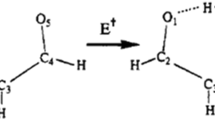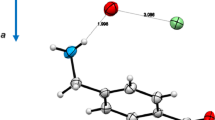Abstract
The crystal structure of natural boehmite, AlOOH, from Tveidalen, Langesundsfjorden, Norway, with a = 3.693(1), b = 12.221(2) and c = 2.865(1) Å, was refined from single crystal X-ray diffraction data (MoKα maximum 2θ = 120°) to an Rw value of 0.032 in space groups Amam and A21am. In both cases the proton was found to occupy positions of the type (x, 0.038, 0), where x = 0.104 and 0.396, about 0.75 Å from the donor oxygen atom. This arrangement corresponds to the presence of chains of asymmetric hydrogen bonds with random polarity parallel to the a axis, and indicates that the effective space group is Amam. No significant electron density was observed either at the center (0, 0, 0) or at the position (1/4, y, 0), corresponding to symmetric and bifurcated hydrogen bonds, respectively, between the layers of octahedra.
Calculations of the total energy of a representative portion of the boehmite structure as a function of hydroxyl orientation, using semiempirical molecular orbitals of the Hückel type, are in agreement with the observed electron density distribution and suggest a preference for (1) sp3, rather than sp2, hybridization of the donor oxygen atom orbitals, and (2) asymmetric, rather than symmetric hydrogen bonds. Disorder of the hydrogen atom positions within individual hydrogen bond chains is shown to be much less likely than disorder between adjacent fully coherent chains.
Резюме
Кристаллическая структура натурального бемита, АlOOН, Твейдалена, Лангезундс- фьерден, Норвегия, с а = 3,693(1), b = 12,221(2), и с = 2,865(1) Å была усовершенствована на основе данных по рентгеновской однокристальной дифракции (МоKα; максимум 2θ = 120°) до величины Rw = 0,032 в пространственных группах Aman и А21am. В обоих случаях было обнаружено, что протон занимает положения типа (х, 0,038, 0), где х = 0,104 и 0,396, около 0,75 Å от донатора кислорода, соответственно присутствию цепных асимметрических водородных связей со случайной полярностью параллельной оси а и указывая на то, что эффективной пространственной группой является Aman. Значительная плотность электронов не наблюдалась ни в центре (0, 0, 0), ни в положении (1/4, у, 0), соответствующем симметрическим и раздвоённым водородным связям, соответственно, между слоями октаэдра.
Расчёты полной энергии характерной части структуры бемита, как функции ориентации гидроокиси, при использовании полуэмпирических молекулярных орбит типа Глюкла находятся в согласии с наблюдаемым распределением плотности электронов, указывая преимущественно на: (1) скорее sp3, чем sp2, гибридизацию орбит донатора кислорода, и (2) скорее асимметрические, чем симметрические водородные связ. Показано, что неупорядоченность положений атомов водорода внутри индивидуальных цепей водородных связей, вероятно, при комнатной температуре, намного меньше, чем неупорядоченность между соседними вполне когерентными цепями. [Е.С.]
Resümee
Die Kristallstruktur von natürlichem Boehmit, AlOOH, von Tveidalen, Langesundsfjord, Norwegen, mit a = 3,693(1), b = 12,221(2), und c = 2,865(1) Å, wurde anhand von Einzelkristalldiffraktometerdaten (MoKα, Maximum 2θ = 120°) auf einen Rw-Wert von 0,032 in den Raumgruppen Amam und A21am verfeinert. In beiden Fällen besetzt das Proton die Position (x, 0,038,0), wobei x = 0,104 und 0,396 ist und etwa 0,75 Å vom Donor-Sauerstoffatom entfernt ist. Dies stimmt damit überein, daß Ketten von assymmetrischen Wasserstoffbrücken vorhanden sind, deren ungefähre Polarität parallel zur a-Achse liegt, was daraufhindeutet, daß die tatsächliche Raumgruppe Amam ist. Es wurde keine bemerkenswerte Elektronendichte beobachtet, weder im Zentrum (0, 0, 0) noch in der Position (1/4, y, 0), entsprechend symmetrischen bzw. sich gabelnden Wasserstoffbrücken zwischen den Oktaederschichten.
Berechnungen der Gesamtenergie eines repräsentativen Teils der Boehmitstruktur als eine Funktion der Hydroxyl-Orientierung mittels halbempirischer MO-Rechnungen (Hückel-Methode) stimmen mit der beobachteten Verteilung der Elektronendichte überein. Dies deutet darauf hin, daß (1) ehereine sp3—als eine sp2—Hybridisierung des Donor-Sauerstofforbitals erfolgt, und (2) eher assymmetrische als symmetrische Wasserstoffbrücken vorhanden sind. Es zeigt sich, daß eine Unordnung von Wasserstoffatom-Positionen innerhalb bestimmter Ketten von Wasserstoffbrücken bei Raumtemperatur weniger wahrscheinlich ist als eine Unordnung zwischen benachbarten koherenten Ketten. [U.W.]
Résumé
La structure cristalline d’une boéhmite naturelle AlOOH de Tveidalen, Langesundsfjorden, Norvège, avec a = 3,693(1),b = 12,221(2), etc = 2,865(1) Å a été rafinée à partir de données de diffraction aux rayons-X d’un seul cristal (MoKα; 2θ maximum = 120°) à une valeur Rw de 0,032 dans les groupes d’espacement Amam et A21am. Dans les deux cas on trouve le proton occupant les positions de type (x, 0,038, 0), où x = 0,104 et 0,0396, à à peu près 0,75 Å de l’atome d’oxygène donateur, correspondant à la présence de chaînes de liens d’hydrogène assymétriques avec une polarité au hasard parallèles à l’axe a, et indiquant que le groupe d’espacement éffectif est Aman. Aucune densité d’électron significative n’a été observée ni au centre (0,0,0) ni àla position ( 1/4, y, 0), correspondant aux liens d’hydrogène symmétriques et bifurqués, respectivement, entre les couches d’octaèdres.
Des calculs de l’énergie totale d’une portion représentative de la structure de la boéhmite en tant que fonction de l’orientation hydroxyl, utilisant des orbites moléculaires semi-empiriques de type Hückel, s’accordent avec la distribution de densité d’électrons observée en suggérant une préférence pour (1) l’hybridisation sp3, plutôt que sp2, des orbites d’atome d’oxygène donateur, et (2) des liens d’hydrogène assymétriques plutôt que symmétriques. Le désordre des positions de l’atome d’hydrogène dans des chaînes individuelles de liens d’hydrogène a été montré être beaucoup moins probable à température ambiante que le désordre entre des chaînes adjacentes totalement cohérentes. [D.J.]
Similar content being viewed by others
References
Allen, L. C. (1970) Why three-dimensional Hückel theory works and where it breaks down: in Sigma Molecular Orbital Theory, O. Sinanoglu and K. B. Wiberg, eds., Yale Univ. Press, New Haven, Connecticut, 227–248.
Atoji, M. and Lipscomb, W. N. (1954) The crystal structure of hydrogen fluoride: Acta Crystallogr. 7, 173–175.
Bartell, L. L., Su, L. S., and Yow, H. (1970) Lengths of phosphorus-oxygen and sulfur-oxygen bonds. An extended Hiickel molecular orbital examination of Cruickshank’s dπ-pπ picture: Inorg. Chem. 9, 1903–1912.
Basch, H., Viste, A., and Gray, H. B. (1965) Valence orbital ionisation potentials from atomic spectral data: Theor. Chim. Acta 3, 458–464.
Bezjak, A. and Jelenic, I. (1964) The crystal structure of boehmite and bayerite: in Symposium sur les Bauxites, Oxydes et Hydroxydes d’Aluminium, Proc. 1st Int. Symp., Zagreb, Yugoslavia. 2, M. Karvulia, ed., 105–111.
Bosnians, H. (1966) Struktuvronderzoek van de Polykristallijne Aluminium Hydroxiden Boehmiet, Bayeriet en Nordstrandiet: Doctoral thesis, Katholieke Univ. Leuven, Belgium, 17 pp.
Boyd, D. B. (1977) Approximate relations between orbital SCF energies and total SCF energies in molecules: J. Chem. Phys. 67, 1787–1788.
Boyd, D. B. (1978) Mapping electron density in molecules. 14. Nonbonded contacts between lone pairs on divalent sulfurs: J. Phys. Chem. 82, 1407–1416.
Busing, W. R. and Levy, H. A. (1958) A single crystal neutron diffraction study of diaspore, AlO(OH): Acta Crystallogr. 11, 798–803.
Christensen, H. and Christensen, A. N. (1978) Hydrogen bonds of γ-FeOOH: Acta Chem. Scand. A32, 87–88.
Christoph, G. G., Corbato, C. E., Hofmann, D. A., and Tettenhorst, R. T. (1979) The crystal structure of boehmite: Clays & Clay Minerals 27, 81–86.
Clementi, E. and Raimondi, D. L. (1963) Atomic screening constants from SCF functions: J. Chem. Phys. 38, 2686–2689.
Coppens, P. (1974) Some implications of combined X-ray and neutron diffraction studies: Acta Crystallogr. B30, 255–261.
Coppens, P. and Hamilton, W. C. (1970) Anisotropic extinction in the Zachariasen approximation: Acta Crystallogr. A26, 71–83.
Dewar, M. J. S. (1975) Computing calculated reactions: Chemistry in Britain 11, 97–106.
Dougherty, J. P. and Kurtz, S. K. (1976) A second harmonic analyzer for the detection of non-centrosymmetry: J. Appl. Crystallogr. 9, 145–158.
Ewing, F. J. (1935) The crystal structure of lepidocrocite: J. Chem. Phys. 3, 420–424.
Farkas, L., Gado, P., and Werner, P.-E. (1977) The structure refinement of boehmite (γ-AlOOH) and the study of its structural variability based on Guinier-Hâgg powder data: Mat. Res. Bull. 12, 1213–1219.
Farmer, V. C. (1980) Raman and i.r. spectra of boehmite (γ-AlOOH) are consistent with D2h16 or C2h5 symmetry: Spectrochim. Acta 36, 585–586.
Ferraris, G. and Franchini-Angela, M. (1972) Survey of the geometry and environment of water molecules in crystalline hydrates studied by neutron diffraction: Acta Crystallogr. B28, 3572–3583.
Fripiat, J. J., Bosmans, H., and Rouxhet, P. G. (1967) Proton mobility in solids. I. Hydrogenic vibration modes and proton delocalization in boehmite: J. Phys. Chem. 71, 1097–1112.
Hamilton, W. C. (1965) Significance tests on the crystallographic R factor: Acta Crystallogr. 18, 502–510.
Hill, R. J. (1979) Crystal structure refinement and electron density distribution in diaspore: Phys. Chem. Miner. 5, 179–200.
Hoffmann, R. (1963) An extended Hiickel theory. I. Hydrocarbons: J. Chem. Phys. 39, 1397–1412.
Holm, C. H., Adams, C. R., and Ibers, J. A. (1958) The hydrogen bond in boehmite: J. Phys. Chem. 62, 992–994.
International Tables for X-ray Crystallography (1974) Vol. IV, J. A. Ibers and W. C. Hamilton, eds., Kynock, Birmingham, England, pp. 19.
Johnson, K.H. (1973) Scattered-wave theory of the chemical bond: Adv. Quant. Chem. 7, 143–185.
Kolesova, V. A. and Ryskin, Ya. I. (1962) Infrared absorption spectra of diaspore (α-AlOOH), boehmite (γ-AlOOH) and GaOOH: J. Struct. Chem. 3, 656–659.
Kroon, D. J. and van der Stolpe, G. (1959) Positions of protons in aluminium hydroxides derived from proton magnetic resonance: Nature 183, 944–945.
Milligan, W. O. and McAtee, J. L. (1956) Crystal structure of γ-AlOOH and γ-ScOOH: J. Phys. Chem. 60, 273–277.
Oles, A., Szytula, A., and Wanic, A. (1970) Neutron diffraction study of γ-FeOOH: Phys. Status Solidi 41, 173–177.
Pauling, L. (1960) The Nature of the Chemical Bond: 3rd ed., Cornell Univ. Press, Ithaca, New York, p. 548
Pople, J. A. and Beveridge, D. L. (1970) Approximate Molecular Orbital Theory: McGraw-Hill, New York, 214 pp.
Reichertz, P. P. and Yost, W. J. (1946) The crystal structure of synthetic boehmite: J. Chem. Phys. 14, 495–501.
Russell, J. D., Farmer, V. C., and Lewis, D. G. (1978) Lattice vibrations of boehmite (γ-AlOOH): evidence for a C2V12 rather than a D2h17 space group: Spectrochim. Acta 34A, 1151–1153.
Sahama, Th. G., Lehtinen, M., and Rehtijärvi, P. (1973) Natural boehmite single crystals from Ceylon: Contr. Min. Petrol. 39, 171–174.
Slade, R. C. T. and Halstead, T. K. (1980) Evidence for proton pairs in γ-AlOOH (boehmite) and NMR absorption spectra: J. Solid State Chem. 32, 119–122.
Stewart, J. M. (ed.) (1976) The XRAY System—Version of 1976: Tech. Rep. TR-446, Computer Science Center, Univ. Maryland, College Park, Maryland.
Stewart, R. F., Davidson, E. R., and Simpson, W. T. (1965) Coherent X-ray scattering for the hydrogen atom in the hydrogen molecule: J. Chem. Phys. 42, 3175–3187.
Thomas, J. O. and Liminga, R. (1978) The electron and proton distribution in the short O–H–O bond in hydrazinium hydrogen oxalate, N2H5HC2O4: Acta Crystallogr. B34, 3686–3690.
Tossell, J. A. and Gibbs, G. V. (1977) Molecular orbital studies of geometries and spectra of minerals and inorganic compounds: Phys. Chem. Miner. 2, 21–57.
Wickersheim, K. A. and Korpi, G. K. (1965) Interpretation of the infrared spectrum of boehmite: J. Chem. Phys. 42, 579–583.
Author information
Authors and Affiliations
Rights and permissions
About this article
Cite this article
Hill, R.J. Hydrogen Atoms in Boehmite: A Single Crystal X-Ray Diffraction and Molecular Orbital Study. Clays Clay Miner. 29, 435–445 (1981). https://doi.org/10.1346/CCMN.1981.0290604
Received:
Accepted:
Published:
Issue Date:
DOI: https://doi.org/10.1346/CCMN.1981.0290604




